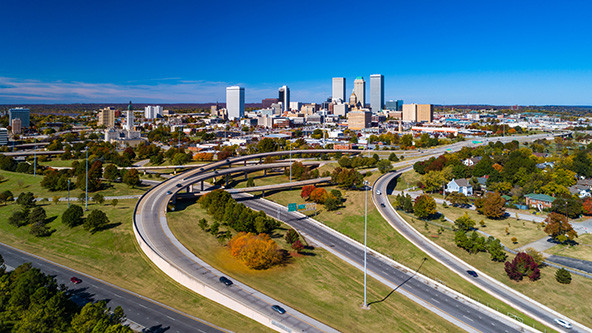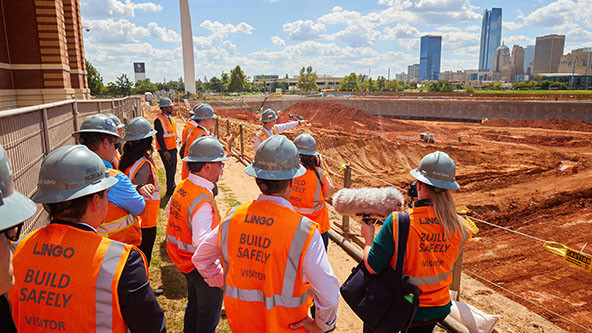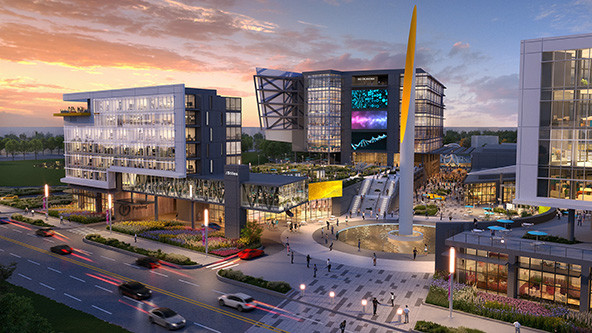Oklahoma’s Build Back Better Regional Challenge Winners: OKC and Tulsa

[ad_1]

(Photo by iStock/Davel5957)
When you think about pioneering hubs of technological innovation, Oklahoma may not be the first place that comes to mind. But thanks to nearly $75 million in federal funding, Oklahoma City and Tulsa are building emerging tech clusters that promise to catalyze inclusive growth and strengthen American competitiveness.
A little more than a year ago, President Joe Biden announced the winners of the Build Back Better Regional Challenge (BBBRC/the Challenge). Part of the American Rescue Plan Act passed in early 2021, BBBRC is one of the largest economic development grant competitions in history, with a billion dollars of funding at stake. The legislation and resulting competition were created to stimulate growth in the wake of the COVID-19 pandemic and to help build the next generation economy the United States needs to compete with international rivals who are surging ahead on a host of technologies.
The Challenge asked coalitions to propose ways to transform their regional economies through interconnected investments in emerging industries. Run by the US Economic Development Administration (EDA), the Challenge received 529 proposals, named 60 finalists, and selected 21 winners. The lucky grantees included clusters on clean energy, next-gen agriculture, advanced manufacturing, semiconductors, and robotics, among others. Surprisingly, Oklahoma was one of only two states to win more than one of these competitive grants (the other was New York). $35 million went to Oklahoma City and $38.2 million went to Tulsa.
The nonprofit I founded, Tulsa Innovation Labs (TIL), led strategy for Tulsa’s proposal. I’ve since left TIL, but I wanted to check in with my colleagues in Oklahoma City and Tulsa to see how the Challenge is going post-award. I know what a game-changer BBBRC has been for winners, but I also know they are facing some thorny challenges in implementing such a complex grant. A year into implementation, both regions have learned important lessons about leadership, governance, DEI, and more.
Cluster Overviews
Like regions throughout the American Heartland, Oklahoma City and Tulsa are comprised of both urban and rural communities. Part of the Challenge’s vision was to help bridge the urban-rural divide, which has contributed to inequality and partisanship. Hence why EDA challenged regions, not just cities, to work together to build high-impact clusters that will benefit people and communities historically shut out of tech. To ensure significant impact, EDA required coalitions to target an emerging industry and develop it through a cluster approach, identifying interventions across sectors, industry segments, and geographies that, together, would catalyze inclusive growth for the region.
In phase 1 of the competition, respondents submitted concepts that outlined their cluster and coalition. Those chosen to advance were awarded a $500,000 technical assistance grant to help build out their applications. In phase 2, the finalists submitted a full proposal, which included an overarching narrative, initiative descriptions, and information regarding coalition structure, governance, and budget.
The Oklahoma Biotech Innovation Cluster is the culmination of a generation’s worth of work to develop Oklahoma City’s bioscience industry. The cluster was formed by the Greater Oklahoma City Chamber in response to BBBRC and is designed to foster a resilient biopharmaceutical supply chain and to encourage global competitiveness through innovation. Oklahoma City saw significant growth in bioscience between 2001 and 2020, with industry employment up 25 percent and R&D activity doubling. The region’s economic development organizations were starting to prioritize inclusion to ensure these dividends extended across socioeconomic groups. Following the pandemic, Oklahoma City said it was at an inflection point and needed federal support to scale.
EDA’s funding for the Oklahoma Biotech Innovation cluster is going to six initiatives: (1) fostering regional cohesion through convenings and policy advocacy; (2) doubling the clinical trial capacity at a University of Oklahoma cancer center (OU); (3) providing non-degree career pathways through a workforce training center; (4) creating ten cancer research labs; (5) cultivating a startup pipeline led by OU; and (6) offering equipment and services for the ecosystem’s bioprocessing needs. While Oklahoma City doesn’t have a hard job count number overall, they said each initiative has metrics around the jobs they’re expected to create.

The construction site for the Oklahoma City Innovation Hall, which will be home to a new workforce training center, funded by EDA. (Photo courtesy of University of Oklahoma)
Tulsa didn’t have decades of growth on which to build, but it did have a cluster strategy that gave the region a head start in the Challenge. In 2020, TIL, with support from the Tulsa-based George Kaiser Family Foundation, created the first tech-led economic development strategy in the city’s history. That strategy identified advanced air mobility as one of the strongest opportunities for growth. The Tulsa Regional Advanced Mobility (TRAM) cluster builds on that foundational work and was designed to transition northeast Oklahoma’s legacy of oil, gas, and traditional manufacturing to advanced mobility, which includes unmanned aerial systems (think drones) and automation. Like a lot of Heartland cities, Tulsa’s manufacturing base was shrinking, and the region was struggling to participate in tech. The area, however, held promising, yet disparate assets, including Oklahoma State University’s (OSU) Unmanned Systems Research Institute, the Osage Nation’s Skyway 36, a drone testing facility outside the city, and 120,000 mostly maintenance and repair workers in the aerospace industry.
The BBBRC grant is funding four initiatives in the Tulsa region: (1) developing a 114-nautical mile “beyond visual line-of-sight” flight test range for new technologies; (2) increasing research capacity for established firms and aspiring entrepreneurs at a new OSU center; (3) providing a series of talent development opportunities, including certificates, degrees, and apprenticeships as well as a Labor Market Observatory to track talent supply and demand; and (4) building a new industrial plant to make 2,000 acres of land attractive to advanced mobility companies to utilize. The cluster’s goal is to generate over 30,000 jobs, economic activity representing $3.5 billion.
Lessons Learned
The Challenge has provided communities with a sudden influx of funds that they’ll need to manage and spend down by fall 2027. This is no easy feat, and regions are now in the stage where neatly designed strategies meet the sometimes-grueling realities of implementation. Based upon interviews conducted via Zoom and email with Madison Jackson, project manager for the Oklahoma Biotech Innovation cluster; Jeffrey Seymour, executive vice president for economic development at the Greater Oklahoma City Chamber; and Kian Kamas, executive director of PartnerTulsa, the City of Tulsa’s new independent economic development authority, several lessons surfaced. Some were shared by both regions, while others reflected divergent experiences or approaches. Three lessons, in particular, are transferable to other communities implementing BBBRC and other large federal grants.
Establish a strong leadership and governance model from the start.
Oklahoma City’s coalition has a singular leader, the Oklahoma City Economic Development Foundation, which is supported by the Greater Oklahoma City Chamber; it is charged with convening BBBRC partners and managing their initiatives. Jackson said their proposal defined a clear governance structure from the beginning and included a budget to fund it, which “many coalitions made the mistake of not doing.” She says the model has enabled Oklahoma City to align with partners on roles and responsibilities, troubleshoot challenges, review milestones and deliverables, and provide transparency across the coalition.
Seymour added that the Challenge, through new entities and initiatives, has also allowed Oklahoma City to “reinvigorate a public sector strategy around support for the statewide bioscience effort.” For the Oklahoma City region, he said, the Chamber is serving as a “single leadership point of contact” to actively think about long-term, big-picture strategy and vet opportunities. This centralization is making implementation of BBBRC relatively smooth.
Tulsa, on the other hand, has a flatter governance structure, without a singular leading organization. While more inclusive on one hand, this model could risk disorganization on the other. Tulsa’s BBBRC response was submitted by the Indian Nations Council of Governments, but for implementation, TIL is taking the lead on innovation and workforce initiatives, while PartnerTulsa is establishing the industrial park, in collaboration with the Tulsa Port. Kamas said that Tulsa has “one of the most diverse groups of implementation partners, which will make our long-term governance approach more complex (but critical!).”
This approach was less intentional and more a reflection of the region’s nascence as a tech hub. Unlike Oklahoma City, Tulsa lacks an anchor institution with the capacity to lead BBBRC’s multiple facets. (TIL and PartnerTulsa are both brand new organizations founded to spur inclusive growth and to fill a leadership and capacity gap). Without a legacy leader, the coalition took on a more dispersed model that played to partner strengths, making overall administration of the grant challenging as roles are a bit more ambiguous and there isn’t the connective tissue amongst partners that Oklahoma City says they’ve built over the past twenty-five years. But that’s why the Challenge was created in the first place, to provide regions the capacity they need to develop and scale emerging tech ecosystems. Kamas said that Tulsa is bringing on additional staff to help refine their governance, oversee equity goals, and support the broader coalition.
Recognize that DEI goes beyond workforce to drive equity in multiple ways.
The Tulsa and Oklahoma City leaders I spoke to each acknowledged that every winning coalition needs to define what DEI means to them—that communities are composed of different peoples with different needs. Ensuring equitable outcomes, however, is exceedingly difficult for any collaboration of this scale and complexity. As a result, when implementing large grants, cities should think about DEI broadly and consider multiple avenues to advance goals. Seymour, for instance, conceded that “from a jobs output, a lot of our projects are in the Innovation District [in Downtown Oklahoma City] which has been a place where historical disparity has occurred.” By not factoring in place, coalitions risk ignoring neighborhoods in need of investment and perpetuating inequities. Seymour says they are working to make sure the community is “meaningfully engaged in the outcomes we’re going to create.”
Jackson followed up with a key point: “A mistake everyone makes with DEI is they only think about workforce, which is one piece of it. But they’re not looking at the other pieces, such as health outcomes or startups.” With biotechnology’s obvious connections to health care, health outcomes is one dimension Oklahoma City hopes to move the needle on. Seymour pointed to the work OU’s Stevenson Center is doing on colorectal cancer in Native American communities as an example: “Our impact is in diverse populations, which then increases livability and employability. If we can do this well, we can have a triple bottom line benefit, which is a special opportunity particularly as more of the growth in the United States is happening in this region.”

A rendering of the Oklahoma City Innovation District plaza. (Courtesy of okcinnovation.com)
In Tulsa, TRAM is taking an intentionally multifaceted approach to DEI. Their workforce programs are designed to support students from underserved backgrounds, offering wrap-around services, scholarships, stipends, and a bridge program to build workplace skills. Tulsa is also looking to make DEI impact beyond talent. The LaunchPad Center for Advanced Air Mobility, for example, has not only activated an underutilized research building at OSU, but is also located in Tulsa’s Greenwood District, a historically Black neighborhood. Greenwood was home to Black Wall Street and the site of the 1921 Tulsa Race Massacre that destroyed it. Working with Black Tech Street, a nonprofit dedicated to positioning Greenwood for the innovation economy, the Center will support Greenwood businesses and drive economic activity in the neighborhood.
Kamas said that Tulsa is “lucky to have major initiatives which we can layer with and align to our BBBRC efforts.” For her, Tulsa’s DEI approach reflects the importance of long-term and long-standing relationships with Greenwood residents, Native American tribes, and others, which are being activated through the grant.
Embrace the experiment by using data to test strategies and track progress.
While most of the winning BBBRC proposals are based on best practices and claim to be supported by rock solid data, in truth, much of tech-led economic development is an experiment. Major federal grants like BBBRC not only offer the opportunity to invest in American communities, but they also allow for experimentation with policy and practice, offering rich learnings for local, regional, and federal actors. In implementing federal grants, communities can often become frustrated that things aren’t working out exactly as planned and they can struggle to adapt. As the leaders I spoke to suggested, coalitions may need to shift mindsets. Kamas, for one, encourages regions to “test and assess strategies to see how they translate into equitable outcomes in neighborhoods.” To take a more flexible approach and encourage organizational learning, coalitions need to develop a practical measurements and evaluation system.
“Everyone is trying to figure it out,” Jackson said, having spoken to a number of other winners about data and metrics. This includes how to develop a data-gathering system and compel submission by partners that satisfies the EDA’s quarterly reporting requirements. For Tulsa, TRAM has focused primarily on initiative implementation, so measurement and evaluation will need to be next year’s priority. Many regions are currently using Google Docs to keep track of relevant data. But the Tulsa and Oklahoma City leaders I spoke to realize this approach isn’t optimal or sustainable. Many organizations lack sophisticated data systems or the culture and capacity to make use of it. One lesson for grant respondents may be to anticipate M&E in their proposals and to devote some thought and budget to creating a system that meets their needs.
For her part, Jackson is upgrading her coalition’s analytics infrastructure. She is working with students from the Massachusetts Institute of Technology to build a dashboard that can “look at data points and feed through different sources that are automatically updated.” The dashboard will include patents, R&D funding, venture capital, as well as more granular data about the cluster and initiative outputs. This data, Jackson said, will help forge new partnerships by breaking down silos and identifying cross-cutting opportunities. A strong data system will allow communities to identify strengths and weaknesses in their work and to adjust accordingly.
Time will tell whether grantees achieve their goals. But it’ll be fascinating to see what they’ll learn along the way. Sure, there have been ribbon cuttings and newspaper headlines, but implementation has only recently begun. Oklahoma City, Tulsa, and the other 19 winners have lots of hard work ahead to achieve their desired outcomes. Given BBBRC’s scale of investment and the diversity of clusters and regions, there are sure to be further lessons about economic development, public-private partnerships, and inclusive tech for years to come. These insights should be shared through peer learning networks to support other regional economic development efforts.
Indeed, for the US to grow in more inclusive ways and to remain competitive on the world stage, it’ll need to invest beyond legacy tech hubs. On Oklahoma’s federal grant boon, Kamas said the state has “…two amazing economic development teams who put together highly compelling visions that EDA felt confident have the ability to propel the American economy through the next century and beyond.” Both Tulsa and Oklahoma City see the Build Back Better Regional Challenge grant as a “springboard” to more investment, innovation, and jobs that can position their regions for success.
Support SSIR’s coverage of cross-sector solutions to global challenges.
Help us further the reach of innovative ideas. Donate today.
Read more stories by Nicholas Lalla.
[ad_2]
Source link
